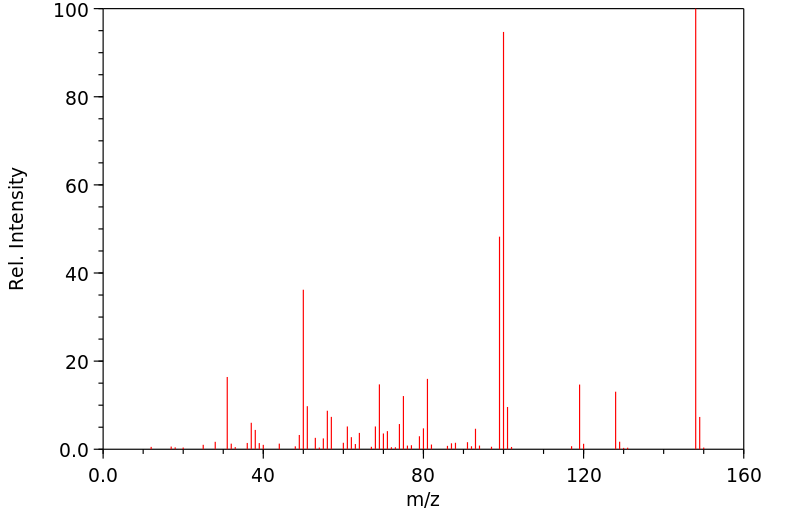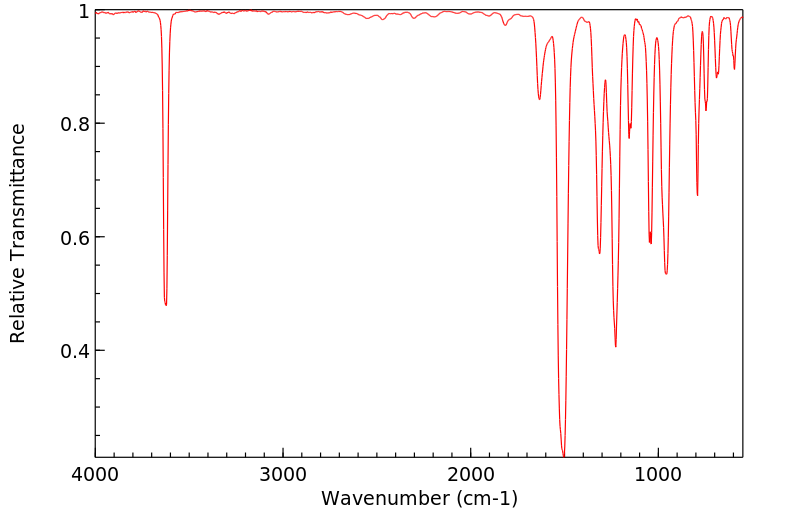2,3,6-三氟苯酚 | 113798-74-6
中文名称
2,3,6-三氟苯酚
中文别名
2,3,6-三氟苯酚, 98+%
英文名称
2,3,6-trifluorophenol
英文别名
——
CAS
113798-74-6
化学式
C6H3F3O
mdl
MFCD00061214
分子量
148.084
InChiKey
QSFGUSFDWCVXNR-UHFFFAOYSA-N
BEILSTEIN
——
EINECS
——
-
物化性质
-
计算性质
-
ADMET
-
安全信息
-
SDS
-
制备方法与用途
-
上下游信息
-
文献信息
-
表征谱图
-
同类化合物
-
相关功能分类
-
相关结构分类
物化性质
-
熔点:33-37 °C (lit.)
-
沸点:137.0±35.0 °C(Predicted)
-
密度:1.456 g/cm
-
闪点:147 °F
-
稳定性/保质期:
在常温常压下稳定,应避免与强氧化剂接触。
计算性质
-
辛醇/水分配系数(LogP):1.9
-
重原子数:10
-
可旋转键数:0
-
环数:1.0
-
sp3杂化的碳原子比例:0.0
-
拓扑面积:20.2
-
氢给体数:1
-
氢受体数:4
安全信息
-
危险等级:4.1
-
危险品标志:Xn,Xi
-
安全说明:S26,S36/37/39
-
危险类别码:R20/21/22
-
WGK Germany:3
-
海关编码:2908199090
-
危险品运输编号:UN 1325 4.1/PG 2
-
包装等级:III
-
危险类别:4.1
-
危险标志:GHS02,GHS07
-
危险性描述:H228,H302,H312,H315,H319,H332,H335
-
危险性防范说明:P210,P261,P280,P305 + P351 + P338
-
储存条件:密封储存,存放在阴凉干燥的库房中,并远离氧化剂。
SDS
| Name: | 2 3 6-Trifluorophenol 98% Material Safety Data Sheet |
| Synonym: | None |
| CAS: | 113798-74-6 |
Synonym:None
Section 2 - COMPOSITION, INFORMATION ON INGREDIENTS
| CAS# | Chemical Name | content | EINECS# |
| 113798-74-6 | 2,3,6-Trifluorophenol | 98% | unlisted |
Risk Phrases: 36/37/38
Section 3 - HAZARDS IDENTIFICATION
EMERGENCY OVERVIEW
Irritating to eyes, respiratory system and skin.
Potential Health Effects
Eye:
Causes eye irritation. May cause chemical conjunctivitis.
Skin:
Causes skin irritation.
Ingestion:
May cause gastrointestinal irritation with nausea, vomiting and diarrhea. The toxicological properties of this substance have not been fully investigated.
Inhalation:
Causes respiratory tract irritation. May cause allergic respiratory reaction. May cause nausea, dizziness, and headache. Can produce delayed pulmonary edema.
Chronic:
Effects may be delayed.
Section 4 - FIRST AID MEASURES
Eyes: Immediately flush eyes with plenty of water for at least 15 minutes, occasionally lifting the upper and lower eyelids. Get medical aid.
Skin:
Get medical aid. Flush skin with plenty of water for at least 15 minutes while removing contaminated clothing and shoes. Wash clothing before reuse.
Ingestion:
Get medical aid. Do NOT induce vomiting. If conscious and alert, rinse mouth and drink 2-4 cupfuls of milk or water. Wash mouth out with water.
Inhalation:
Remove from exposure and move to fresh air immediately. If not breathing, give artificial respiration. If breathing is difficult, give oxygen. Get medical aid.
Notes to Physician:
Treat symptomatically and supportively.
Section 5 - FIRE FIGHTING MEASURES
General Information:
As in any fire, wear a self-contained breathing apparatus in pressure-demand, MSHA/NIOSH (approved or equivalent), and full protective gear. During a fire, irritating and highly toxic gases may be generated by thermal decomposition or combustion.
Extinguishing Media:
Use agent most appropriate to extinguish fire. Use water spray, dry chemical, carbon dioxide, or appropriate foam.
Section 6 - ACCIDENTAL RELEASE MEASURES
General Information: Use proper personal protective equipment as indicated in Section 8.
Spills/Leaks:
Vacuum or sweep up material and place into a suitable disposal container. Clean up spills immediately, observing precautions in the Protective Equipment section. Avoid generating dusty conditions.
Provide ventilation.
Section 7 - HANDLING and STORAGE
Handling:
Minimize dust generation and accumulation. Avoid contact with eyes, skin, and clothing. Keep container tightly closed. Avoid ingestion and inhalation. Use with adequate ventilation. Wash clothing before reuse.
Storage:
Store in a tightly closed container. Store in a cool, dry, well-ventilated area away from incompatible substances.
Section 8 - EXPOSURE CONTROLS, PERSONAL PROTECTION
Engineering Controls:
Facilities storing or utilizing this material should be equipped with an eyewash facility and a safety shower. Use adequate ventilation to keep airborne concentrations low.
Exposure Limits CAS# 113798-74-6: Personal Protective Equipment Eyes: Wear appropriate protective eyeglasses or chemical safety goggles as described by OSHA's eye and face protection regulations in 29 CFR 1910.133 or European Standard EN166.
Skin:
Wear appropriate protective gloves to prevent skin exposure.
Clothing:
Wear appropriate protective clothing to prevent skin exposure.
Respirators:
A respiratory protection program that meets OSHA's 29 CFR 1910.134 and ANSI Z88.2 requirements or European Standard EN 149 must be followed whenever workplace conditions warrant respirator use.
Section 9 - PHYSICAL AND CHEMICAL PROPERTIES
Physical State: Solid
Color: off-white
Odor: Not available.
pH: Not available.
Vapor Pressure: Not available.
Viscosity: Not available.
Boiling Point: Not available.
Freezing/Melting Point: 33 - 37 deg C
Autoignition Temperature: Not available.
Flash Point: 63 deg C ( 145.40 deg F)
Explosion Limits, lower: Not available.
Explosion Limits, upper: Not available.
Decomposition Temperature:
Solubility in water:
Specific Gravity/Density:
Molecular Formula: C6H3F3O
Molecular Weight: 148.09
Section 10 - STABILITY AND REACTIVITY
Chemical Stability:
Stable at room temperature in closed containers under normal storage and handling conditions.
Conditions to Avoid:
Incompatible materials, dust generation, excess heat.
Incompatibilities with Other Materials:
Strong oxidizing agents.
Hazardous Decomposition Products:
Carbon monoxide, irritating and toxic fumes and gases, carbon dioxide, hydrogen fluoride gas.
Hazardous Polymerization: Will not occur.
Section 11 - TOXICOLOGICAL INFORMATION
RTECS#:
CAS# 113798-74-6 unlisted.
LD50/LC50:
Not available.
Carcinogenicity:
2,3,6-Trifluorophenol - Not listed by ACGIH, IARC, or NTP.
Section 12 - ECOLOGICAL INFORMATION
Section 13 - DISPOSAL CONSIDERATIONS
Dispose of in a manner consistent with federal, state, and local regulations.
Section 14 - TRANSPORT INFORMATION
IATA
Not regulated as a hazardous material.
IMO
Not regulated as a hazardous material.
RID/ADR
Not regulated as a hazardous material.
Section 15 - REGULATORY INFORMATION
European/International Regulations
European Labeling in Accordance with EC Directives
Hazard Symbols: XI
Risk Phrases:
R 36/37/38 Irritating to eyes, respiratory system
and skin.
Safety Phrases:
S 26 In case of contact with eyes, rinse immediately
with plenty of water and seek medical advice.
S 37/39 Wear suitable gloves and eye/face
protection.
WGK (Water Danger/Protection)
CAS# 113798-74-6: No information available.
Canada
None of the chemicals in this product are listed on the DSL/NDSL list.
CAS# 113798-74-6 is not listed on Canada's Ingredient Disclosure List.
US FEDERAL
TSCA
CAS# 113798-74-6 is not listed on the TSCA inventory.
It is for research and development use only.
SECTION 16 - ADDITIONAL INFORMATION
N/A
制备方法与用途
2,3,6-三氟苯酚是一种酚类有机物,可用作有机合成中间体。据文献报道,它还可用于制备一种新型的含磷阻燃剂,并可作为非水电解液二次电池电解液中的阻燃添加剂。
上下游信息
-
下游产品
中文名称 英文名称 CAS号 化学式 分子量 —— 4-bromo-2,3,6-trifluorophenol 192446-70-1 C6H2BrF3O 226.98 2,3,5-三氟-4-羟基苯甲醛 2,3,5-trifluoro-4-hydroxy-benzaldehyde 676500-50-8 C7H3F3O2 176.095 —— 1-bromo-2,3,5-trifluoro-4-methoxybenzene 13332-25-7 C7H4BrF3O 241.007
反应信息
-
作为反应物:描述:2,3,6-三氟苯酚 在 ammonium hydroxide 、 tyrosine phenollylase 、 磷酸吡哆醛 、 ammonium acetate 、 sodium carbonate 、 2-巯基乙醇 作用下, 以 1,4-二氧六环 、 水 为溶剂, 生成 (S)-2-(9H-Fluoren-9-ylmethoxycarbonylamino)-3-(2,3,5-trifluoro-4-hydroxy-phenyl)-propionic acid参考文献:名称:蛋白质酪氨酸激酶反应过渡态的正向和反向动力学分析摘要:蛋白质酪氨酸激酶催化 γ-磷酰基从 ATP 转移到蛋白质中的酪氨酸残基,是细胞信号转导中的重要酶。我们通过分析一系列含氟酪氨酸的肽底物,研究了由 Csk 催化的蛋白质酪氨酸激酶反应的催化磷酰基转移过渡态。对于五种这样的含氟酪氨酸的肽底物已经确定,酪氨酸类似物苯酚 pKa 和负责 pH 速率曲线分析的基本分支的可电离基团之间存在良好的一致性。这表明底物酪氨酸苯酚必须是中性的才能具有酶活性。结合之前的数据表明一个小的 β 亲核系数(0-0.1),这些结果强烈支持磷酰基转移的解离过渡态。此外,β-离开基团系数是为反向蛋白酪氨酸激酶反应测量的,显示为-0.3。这个值很好...DOI:10.1021/ja9808393
-
作为产物:描述:参考文献:名称:Allen, Kim J.; Bolton, Roger; Williams, Gareth H., Journal of the Chemical Society. Perkin transactions II, 1983, p. 691 - 696摘要:DOI:
文献信息
-
一种电解液阻燃添加剂及其制备方法和应用
-
可用作皮质儿茶酚胺能神经传递调节剂的新型氮杂环丁烷衍生物申请人:综合研究实验室瑞典股份公司公开号:CN109963834B公开(公告)日:2023-04-14本发明提供了一种药物组合物,其包含:治疗有效量的式(I)的化合物、或其同位素标记的类似物、或其药学上可接受的盐,其中:R1、R2、R3、R6和R7各自表示H或F,R4表示H或CH3,R5表示H或C1‑C4烷基,其中R1、R2、R3、R6和R7中的至少两个表示F;以及至少一种药学上可接受的载体、赋形剂和/或稀释剂。
-
[EN] DIAZABICYCLONONENE AND TETRAHYDROPYRIDINE DERIVATIVES AS RENIN INHIBITORS<br/>[FR] DERIVES DE DIAZABICYCLONONENE ET DE TETRAHYDROPYRIDINE UTILISES COMME INHIBITEURS DE LA RENINE申请人:ACTELION PHARMACEUTICALS LTD公开号:WO2004096804A1公开(公告)日:2004-11-11The invention relates to novel 3,9-diazabicyclo[3.3.1]nonene derivatives, tetrahydropyridine derivatives, and related compounds and their use as active ingredients in the preparation of pharmaceutical compositions. The invention also concerns related aspects including processes for the preparation of the compounds, pharmaceutical compositions containing one or more of those compounds and especially their use as inhibitors of renin.
-
Novel Piperidine Carboxylic Acid Amide Derivatives申请人:Bezencon Olivier公开号:US20080214598A1公开(公告)日:2008-09-04The invention relates to novel piperidine carboxylic acid amide derivatives and their use as active ingredients in the preparation of pharmaceutical compositions. The invention also concerns related aspects including processes for the preparation of these novel compounds, pharmaceutical compositions comprising such compounds and especially the use of such compounds as inhibitors of renin.
-
Design and Preparation of Potent, Nonpeptidic, Bioavailable Renin Inhibitors作者:Olivier Bezençon、Daniel Bur、Thomas Weller、Sylvia Richard-Bildstein、Luboš Remeň、Thierry Sifferlen、Olivier Corminboeuf、Corinna Grisostomi、Christoph Boss、Lars Prade、Stéphane Delahaye、Alexander Treiber、Panja Strickner、Christoph Binkert、Patrick Hess、Beat Steiner、Walter FischliDOI:10.1021/jm900022f日期:2009.6.25Starting from known piperidine renin inhibitors, a new series of 3,9-diazabicyclo[3.3.1]nonene derivatives was rationally designed and prepared. Optimization of the positions 3, 6, and 7 of the diazabicyclonene template led to potent renin inhibitors. The substituents attached at the positions 6 and 7 were essential for the binding affinity of these compounds for renin. The introduction of a substituent
表征谱图
-
氢谱1HNMR
-
质谱MS
-
碳谱13CNMR
-
红外IR
-
拉曼Raman
-
峰位数据
-
峰位匹配
-
表征信息
同类化合物
(2-氯-6-羟基苯基)硼酸
黄柄曲菌素
高香草酸-d3
高香草酸-13C6
高香草酸
高香兰酸乙酯
高辣椒素II
高二氢辣椒素I
香草醛醛肟
香草醛苯腙
香草醛-甲氧基-13C
香草醛-(N-对甲苯基肟)
香草醛
香草酸肼
香草壬酰胺
香草基扁桃酸乙酯
香草吗啉
香草二乙胺
香兰素胺硬脂酸盐
香兰素胺硬脂酸盐
香兰素胺盐酸盐
香兰素丙二醇缩醛
香兰素13C6
香兰素-D3
香兰基乙基醚
香兰基丁醚
顺式-5-正十五碳-8'-烯基间苯二酚
顺式-1-(2-羟基-5-甲基苯基)-2-丁烯-1-酮
顺式-1-(2-羟基-4-甲氧基苯基)-2-丁烯-1-酮
顺-3-氯二氢-5-苯基呋喃-2(3H)-酮
雌二醇杂质1
降二氢辣椒碱
阿诺洛尔
阿瓦醇
阿普斯特杂质
间苯二酚双(二苯基磷酸酯)
间苯二酚-烯丙醇聚合物
间苯二酚-D6
间苯二酚
间苯三酚甲醛
间苯三酚二水合物
间苯三酚
间羟基苯乙基溴
间硝基苯酚
间甲酚紫钠盐
间甲酚与对甲酚和苯酚甲醛树脂的聚合物
间甲酚-D7
间甲酚-D3
间甲酚
间溴苯酚








